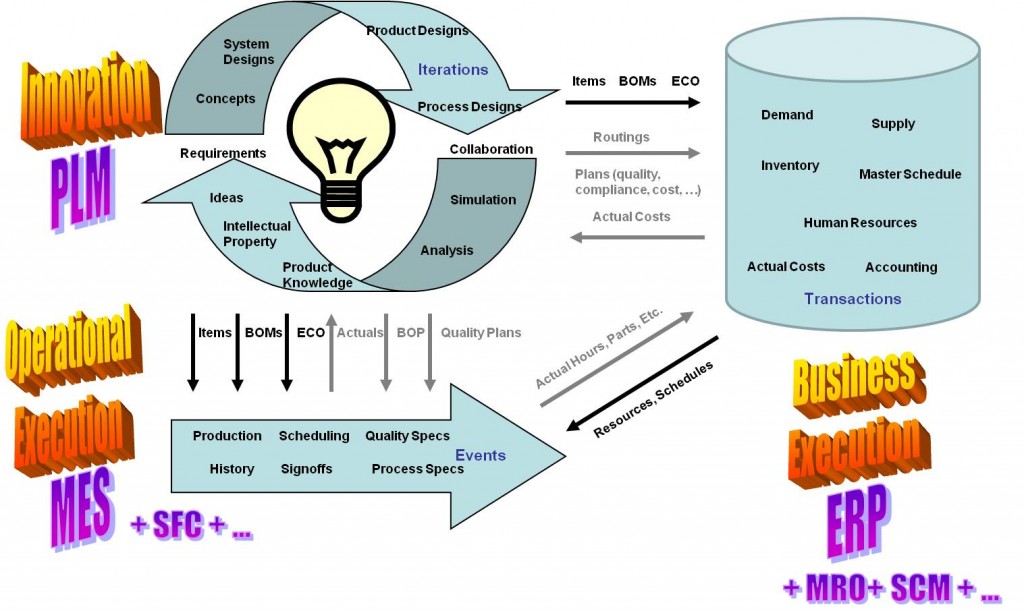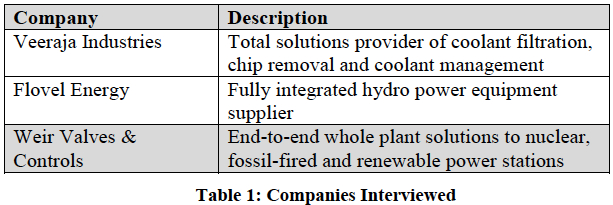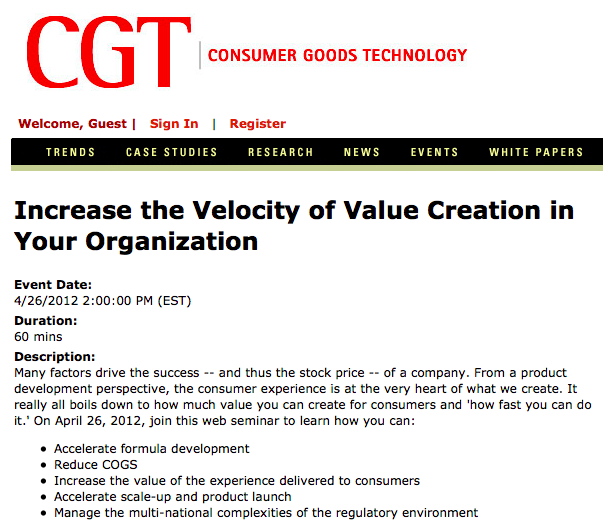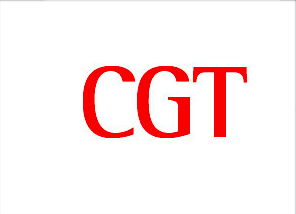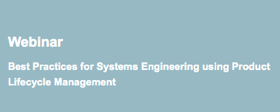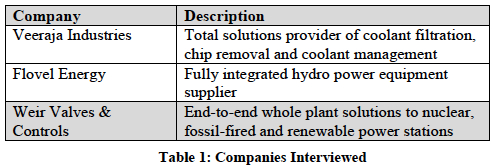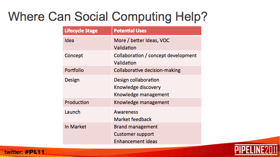Take a look at this webcast on Dr. Dobb’s to hear me discuss some tips on how manufacturers can use systems engineering best practices to improve product development. There is more embedded software in today’s products than ever – it’s time for manufacturers to learn how to take advantage of the opportunities it offers while…
- Introducing the Issue
- Consolidate Upstream from Detailed Design
- Consolidate Downstream from Detailed Design
- Live with Supply Chain Realities (Multi-CAD)
- Leverage the Past (Legacy Designs)
- Understand the Bigger Picture
- Address the Pain (with a Little Help from IT)
- The Expanded ROI Model
- Conclusion
- Recommendations
- About the Author
 Please join us as Jim Brown presents his research on Product Portfolio Management (PPM) in this CGT webcast, How to Effectively Manage Your Product Portfolio to Consistently Hit Launch Windows. Please join the live event on August 16 or view the on-demand, recorded webcast at your convenience.
Jim is joining Monica Alderson, Project Management Director for Consumer Solutions at Hallmark Cards and Carrie Nauyalis, NPD Solution Marketing Manager, Planview in an interactive discussion about what to do when time to market gets critical due to inflexible launch windows driven by external forces. As one consumer goods industry insider likes to say, "You can't negotiate with Christmas."
View the replay of this CGT webacast, sponsored by Planview
Please join us as Jim Brown presents his research on Product Portfolio Management (PPM) in this CGT webcast, How to Effectively Manage Your Product Portfolio to Consistently Hit Launch Windows. Please join the live event on August 16 or view the on-demand, recorded webcast at your convenience.
Jim is joining Monica Alderson, Project Management Director for Consumer Solutions at Hallmark Cards and Carrie Nauyalis, NPD Solution Marketing Manager, Planview in an interactive discussion about what to do when time to market gets critical due to inflexible launch windows driven by external forces. As one consumer goods industry insider likes to say, "You can't negotiate with Christmas."
View the replay of this CGT webacast, sponsored by Planview
 [post_title] => Webcast on Meeting Inflexible Product Development Launch Windows
[post_excerpt] =>
[post_status] => publish
[comment_status] => open
[ping_status] => open
[post_password] =>
[post_name] => webcast-windows
[to_ping] =>
[pinged] =>
[post_modified] => 2022-11-14 22:26:32
[post_modified_gmt] => 2022-11-15 03:26:32
[post_content_filtered] =>
[post_parent] => 0
[guid] => http://tech-clarity.com/?p=2286
[menu_order] => 0
[post_type] => post
[post_mime_type] =>
[comment_count] => 0
[filter] => raw
)
[3] => WP_Post Object
(
[ID] => 2250
[post_author] => 2
[post_date] => 2012-07-11 10:02:39
[post_date_gmt] => 2012-07-11 14:02:39
[post_content] =>
[post_title] => Webcast on Meeting Inflexible Product Development Launch Windows
[post_excerpt] =>
[post_status] => publish
[comment_status] => open
[ping_status] => open
[post_password] =>
[post_name] => webcast-windows
[to_ping] =>
[pinged] =>
[post_modified] => 2022-11-14 22:26:32
[post_modified_gmt] => 2022-11-15 03:26:32
[post_content_filtered] =>
[post_parent] => 0
[guid] => http://tech-clarity.com/?p=2286
[menu_order] => 0
[post_type] => post
[post_mime_type] =>
[comment_count] => 0
[filter] => raw
)
[3] => WP_Post Object
(
[ID] => 2250
[post_author] => 2
[post_date] => 2012-07-11 10:02:39
[post_date_gmt] => 2012-07-11 14:02:39
[post_content] => 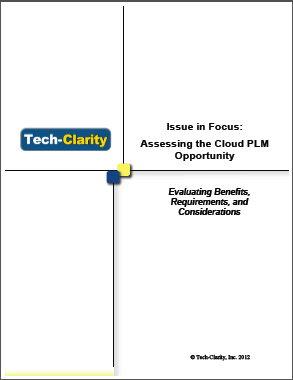 Issue in Focus: Assessing the Cloud PLM Opportunity: Evaluating the Benefits, Requirements, and Considerations explores the opportunity to leverage cloud computing technology with PLM (Product Lifecycle Management). The paper is intended to help companies evauluating PLM in the cloud by sharing information and experiences from more mature cloud enterprise applications including CRM.
Please enjoy the free Executive Summary below, or click the report title above to download a PDF that overviews the report (free of charge, no registration required).
For the full report, please visit the Autodesk PLM360 Resource Center under Analyst Research (no registration required).
Table of Contents
Issue in Focus: Assessing the Cloud PLM Opportunity: Evaluating the Benefits, Requirements, and Considerations explores the opportunity to leverage cloud computing technology with PLM (Product Lifecycle Management). The paper is intended to help companies evauluating PLM in the cloud by sharing information and experiences from more mature cloud enterprise applications including CRM.
Please enjoy the free Executive Summary below, or click the report title above to download a PDF that overviews the report (free of charge, no registration required).
For the full report, please visit the Autodesk PLM360 Resource Center under Analyst Research (no registration required).
Table of Contents
- Introducing the Issue
- The Cloud Meets PLM
- Evaluating the Key Features and Benefits of Cloud Computing
- Leverage Economies of Scale
- Eliminate Non-Value Added Work
- Take Advantage of Cloud Level Systems Performance
- Enhance Flexibility and Agility, Reduce Business Risk
- Final Considerations
- Conclusion
- Recommendations
- About the Author
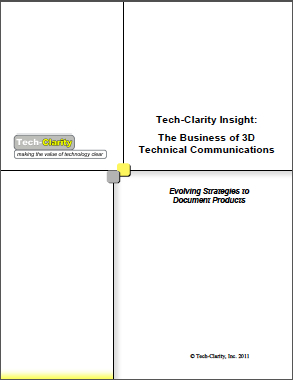 Tech-Clarity Insight: The Business of 3D Technical Communications: Evolving Strategies to Document Products explains how companies are changing their views on technical documentation to a more strategic approach, including the use of 3D to go beyond flat, static documents to incorporate richer, interactive, more realistic representation of products.
Please enjoy the free Executive Summary below, or click the report title above to download a PDF that overviews the report (free of charge, no registration required). For the full report visit the Dassault Systemes website (registration required).
Table of Contents
Tech-Clarity Insight: The Business of 3D Technical Communications: Evolving Strategies to Document Products explains how companies are changing their views on technical documentation to a more strategic approach, including the use of 3D to go beyond flat, static documents to incorporate richer, interactive, more realistic representation of products.
Please enjoy the free Executive Summary below, or click the report title above to download a PDF that overviews the report (free of charge, no registration required). For the full report visit the Dassault Systemes website (registration required).
Table of Contents
- Executive Overview
- 3D Product Communication: Operational View
- 3D Product Communication: Strategic View
- Improve Technical Documentation Efficiency
- Improve Engineering Efficiency
- Improve Documentation and Communication
- Improve Collaboration
- Improve Manufacturing
- Improve Service
- Get Started
- Extend the Business Value
- Conclusion
- Recommendations
- About the Author
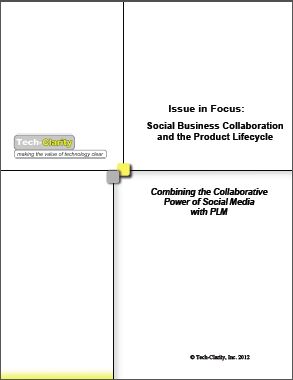 Issue in Focus: Social Business Collaboration and the Product Lifecycle: Combining the Collaborative Power of Social Media with PLM explores the possibility that companies could adopt a social business collaboration platform to improve product development processes and add proven PLM capabilities as needed to establish a socially capable PLM system.
Tech-Clarity believes that social product innovation is inevitable due to the inherent social nature of product development and the enhanced collaborative capabilities that social computing offers. But the assumption was that PLM solutions would adopt social computing concepts because it was too much to reinvent the PLM wheel in social media. But what if that prediction was wrong? Perhaps there is another path – one that brings PLM capabilities to social software. This report explores the possibility that companies could adopt a social business collaboration platform to improve product lifecycle management (PLM) processes and add proven PLM capabilities as needed.
Please enjoy the free Executive Summary below, or click the report title above to download the full PDF (free of charge, no registration required).
Table of Contents
Issue in Focus: Social Business Collaboration and the Product Lifecycle: Combining the Collaborative Power of Social Media with PLM explores the possibility that companies could adopt a social business collaboration platform to improve product development processes and add proven PLM capabilities as needed to establish a socially capable PLM system.
Tech-Clarity believes that social product innovation is inevitable due to the inherent social nature of product development and the enhanced collaborative capabilities that social computing offers. But the assumption was that PLM solutions would adopt social computing concepts because it was too much to reinvent the PLM wheel in social media. But what if that prediction was wrong? Perhaps there is another path – one that brings PLM capabilities to social software. This report explores the possibility that companies could adopt a social business collaboration platform to improve product lifecycle management (PLM) processes and add proven PLM capabilities as needed.
Please enjoy the free Executive Summary below, or click the report title above to download the full PDF (free of charge, no registration required).
Table of Contents
- Introducing the Issue
- Why Social Business Collaboration Makes Sense
- Why Social Business Makes Sense for Product Development
- What will Socially Capable PLM Look Like?
- How Do We Get There?
- Social Software Goes PLM
- Conclusion
- Recommendations
- About the Author
- Lack of understanding and integration with product data
- Insufficient security and intellectual property (IP) protection
- Minimal support for managing business processes
- Lack of domain expertise
- Disconnection from the underlying context – the product
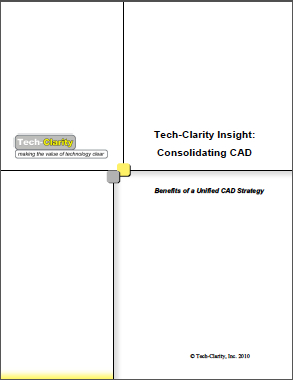 Tech-Clarity Insight: Consolidating CAD - Benefits of a Unified CAD Strategy examines the strategic and tactical value of standardizing on a single CAD package. The research papers provides a framework for determining the cost savings available from consolidating tools.
Please enjoy the free Executive Summary below, or click the report title above to download the full PDF (free of charge, no registration required).
Note: We are in the process of updating this research to consider the integration of broader design suites beyond mechanical CAD for detailed design. Stay tuned...
Table of Contents
Tech-Clarity Insight: Consolidating CAD - Benefits of a Unified CAD Strategy examines the strategic and tactical value of standardizing on a single CAD package. The research papers provides a framework for determining the cost savings available from consolidating tools.
Please enjoy the free Executive Summary below, or click the report title above to download the full PDF (free of charge, no registration required).
Note: We are in the process of updating this research to consider the integration of broader design suites beyond mechanical CAD for detailed design. Stay tuned...
Table of Contents
- Executive Overview
- Lean IT Overhead
- Reuse
- Collaboration
- Enabling the Bigger Product Development Picture
- The Corporate Advantage
- Conclusion
- Recommendations
- About the Author
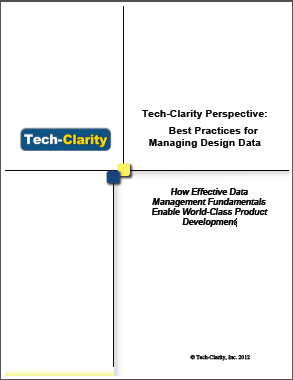 shares survey results on the processes and technology that top-performing manufacturers use to manage their technical product data. The survey benchmarks manufacturers on their design performance and determines which respondents outperform the others in:
shares survey results on the processes and technology that top-performing manufacturers use to manage their technical product data. The survey benchmarks manufacturers on their design performance and determines which respondents outperform the others in:
- Designing high quality products
- Developing products quickly
- Developing innovative products
- Developing products efficiently
- Executive Overview
- Importance of Effective Data Management
- Data Management Challenges Impact Time and Quality
- Complexity, more than Size, Creates Issues
- Wasting Time on Nonproductive Data Management
- Identifying the Top Business Performers
- Best Data Management Practices of World Class Companies
- Enabling World Class Data Management (and results)
- Conclusion
- Recommendations
- About the Author
- About the Research
- Are more able to find the data they need, share it with others, manage their design projects, and provide the correct data to manufacturing
- Spend 25% less time on nonproductive data management tasks
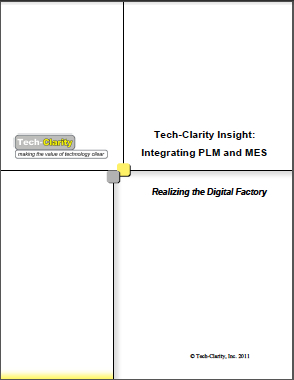 Tech-Clarity Insight Integrating PLM and MES - Realizing the Digital Factory expands the discussion on the roles that ERP and PLM play in manufacturing to include the role of Manufacturing Execution Systems (MES). The paper discusses the business need for integrating the solutions, automating the integrated product and production lifecycle, and closing the loop between designs and products. The report includes experiences shared through interviews with a leading aerospace manufacturer, a Siemens electronics plant, and ATK Space Systems.
Please enjoy the free Executive Summary below, or click the report title above to download the full PDF (free of charge, no registration required).
Table of Contents
Tech-Clarity Insight Integrating PLM and MES - Realizing the Digital Factory expands the discussion on the roles that ERP and PLM play in manufacturing to include the role of Manufacturing Execution Systems (MES). The paper discusses the business need for integrating the solutions, automating the integrated product and production lifecycle, and closing the loop between designs and products. The report includes experiences shared through interviews with a leading aerospace manufacturer, a Siemens electronics plant, and ATK Space Systems.
Please enjoy the free Executive Summary below, or click the report title above to download the full PDF (free of charge, no registration required).
Table of Contents
- Executive Overview
- Why Now?
- Product Innovation and Execution Roles
- Integrating the Product and Production Lifecycle
- Automating the Integrated Product and Production Lifecycle
- Closing the Loop between Designs and Products
- Summary
- Recommendations
- About the Author
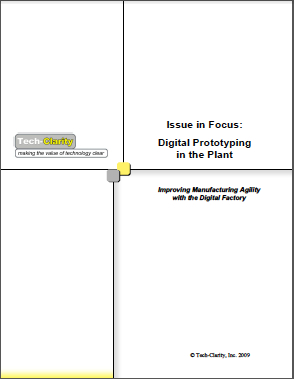 Tech-Clarity Issue in Focus: Digital Prototyping in the Plant: Improving Manufacturing Agility with the Digital Factory discusses how digital prototyping solutions can help manufacturers achieve greater agility by leveraging a digital factory approach. This is particularly important today as the manufacturing industries - particularly the automotive industry - are faced with the need to drastically improve efficiency and adapt to rapidly changing market and production landscapes.
Please enjoy the free Executive Summary below, or click the report title above to download the full PDF (free of charge, no registration required).
Table of Contents
Tech-Clarity Issue in Focus: Digital Prototyping in the Plant: Improving Manufacturing Agility with the Digital Factory discusses how digital prototyping solutions can help manufacturers achieve greater agility by leveraging a digital factory approach. This is particularly important today as the manufacturing industries - particularly the automotive industry - are faced with the need to drastically improve efficiency and adapt to rapidly changing market and production landscapes.
Please enjoy the free Executive Summary below, or click the report title above to download the full PDF (free of charge, no registration required).
Table of Contents
- Introducing the Issue
- Adapting and Optimizing Workstations, Lines and Plants
- Designing Optimal Tooling and Equipment
- Collaborating Electronically to Retool the Plant
- Conclusion
- Recommendations
- About the Author
 Register for the Event
[post_title] => Systems Engineering and PLM Webcast
[post_excerpt] =>
[post_status] => publish
[comment_status] => open
[ping_status] => open
[post_password] =>
[post_name] => systems-engineering-plm-webcast
[to_ping] =>
[pinged] =>
[post_modified] => 2022-11-14 22:26:32
[post_modified_gmt] => 2022-11-15 03:26:32
[post_content_filtered] =>
[post_parent] => 0
[guid] => http://tech-clarity.com/?p=2116
[menu_order] => 0
[post_type] => post
[post_mime_type] =>
[comment_count] => 0
[filter] => raw
)
[11] => WP_Post Object
(
[ID] => 2107
[post_author] => 2
[post_date] => 2012-05-14 20:53:05
[post_date_gmt] => 2012-05-15 00:53:05
[post_content] =>
Register for the Event
[post_title] => Systems Engineering and PLM Webcast
[post_excerpt] =>
[post_status] => publish
[comment_status] => open
[ping_status] => open
[post_password] =>
[post_name] => systems-engineering-plm-webcast
[to_ping] =>
[pinged] =>
[post_modified] => 2022-11-14 22:26:32
[post_modified_gmt] => 2022-11-15 03:26:32
[post_content_filtered] =>
[post_parent] => 0
[guid] => http://tech-clarity.com/?p=2116
[menu_order] => 0
[post_type] => post
[post_mime_type] =>
[comment_count] => 0
[filter] => raw
)
[11] => WP_Post Object
(
[ID] => 2107
[post_author] => 2
[post_date] => 2012-05-14 20:53:05
[post_date_gmt] => 2012-05-15 00:53:05
[post_content] => 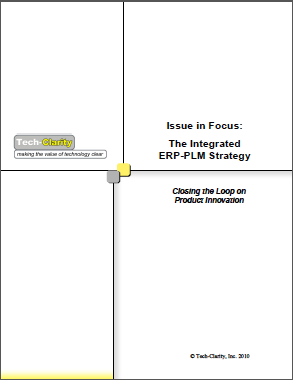 Insight: The Integrated ERP-PLM Strategy: Closing the Loop on Product Innovation reviews the importance of an integrated ERP-PLM strategy to provide a rapid, confident flow of innovation information to and from Manufacturing. The paper discusses a strategy to close the loop between Engineering and Manufacturing to get the most business value from innovation in all its forms.
Please enjoy the free Executive Summary below, or click the report title above to download the full PDF (free of charge, no registration required).
Table of Contents
Insight: The Integrated ERP-PLM Strategy: Closing the Loop on Product Innovation reviews the importance of an integrated ERP-PLM strategy to provide a rapid, confident flow of innovation information to and from Manufacturing. The paper discusses a strategy to close the loop between Engineering and Manufacturing to get the most business value from innovation in all its forms.
Please enjoy the free Executive Summary below, or click the report title above to download the full PDF (free of charge, no registration required).
Table of Contents
- Introducing the Issue
- What to Expect from ERP
- What to Expect from PLM
- Closing the Loop on Product Innovation
- Developing the ERP-PLM Strategy
- Conclusion
- Recommendations
- About the Author
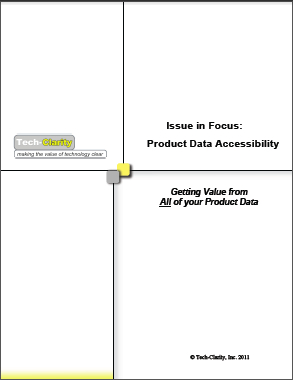 Issue in Focus: Product Data Accessibility: Getting Value from All of Your Product Data explains the importance for manufacturers to be able to access and share product data, regardless of whether it is centralized in a system like PDM or not. Explains that accessing product data and centralizing it are not absolutely linked, and describes emerging technologies that can help.
Please enjoy the free Executive Summary below, or click the report title above to download the full PDF (free of charge, no registration required).
Table of Contents
Issue in Focus: Product Data Accessibility: Getting Value from All of Your Product Data explains the importance for manufacturers to be able to access and share product data, regardless of whether it is centralized in a system like PDM or not. Explains that accessing product data and centralizing it are not absolutely linked, and describes emerging technologies that can help.
Please enjoy the free Executive Summary below, or click the report title above to download the full PDF (free of charge, no registration required).
Table of Contents
- Introducing the Issue
- Access All of Your Product Data
- Virtually Consolidate Data from Disparate Locations
- Liberate Product Data from Disparate Applications
- Aggregate and Use All Product Data
- Conclusion
- Recommendations
- About the Author
- Control and secure product-related data
- Improve the ability to quickly find and reuse information
- Share product knowledge with other departments
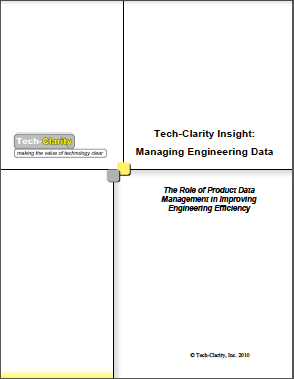 Tech-Clarity Insight: Managing Engineering Data - The Role of Product Data Management in Improving Engineering Efficiency shares the benefits of controlling engineering data and collaborating with PDM. The research discusses extending PDM with product-related processes and expanding implementations beyond engineering data.
Please enjoy the free Executive Summary below, or click the report title above to download the full PDF (free of charge, no registration required).
Table of Contents
Tech-Clarity Insight: Managing Engineering Data - The Role of Product Data Management in Improving Engineering Efficiency shares the benefits of controlling engineering data and collaborating with PDM. The research discusses extending PDM with product-related processes and expanding implementations beyond engineering data.
Please enjoy the free Executive Summary below, or click the report title above to download the full PDF (free of charge, no registration required).
Table of Contents
- Executive Overview
- PDM and the Business Strategy
- Gaining Control of Product Data with PDM
- Collaborating with PDM
- Automating Product-Related Processes
- Leveraging PDM beyond Engineering Data
- Conclusion
- Recommendations
- About the Author
 Tech-Clarity Insight: The Business Value of Product Data Management: Achieving Rapid and Extendable Benefits explains how manufacturers use PDM to control their product data, improve their ability to find information, and better share knowledge with other departments. The report shares the experiences of three manufacturers that took a more "out of the box" approach to reach these benefits quickly.
Note: This report has been updated, please see the current version of the report here.
Table of Contents
Tech-Clarity Insight: The Business Value of Product Data Management: Achieving Rapid and Extendable Benefits explains how manufacturers use PDM to control their product data, improve their ability to find information, and better share knowledge with other departments. The report shares the experiences of three manufacturers that took a more "out of the box" approach to reach these benefits quickly.
Note: This report has been updated, please see the current version of the report here.
Table of Contents
- Executive Overview
- The Business Value of PDM – Controlling Product Data
- The Business Value of PDM – Making Product Data Accessible
- The Business Value of PDM – Sharing Product Data
- Achieving Value Quickly (and Painlessly)
- Getting Started
- Taking Advantage of (and Extending) the Benefits
- Conclusion
- Recommendations
- About the Author
- Control and secure product-related data
- Improve the ability to quickly find and reuse information
- Share product knowledge with other departments
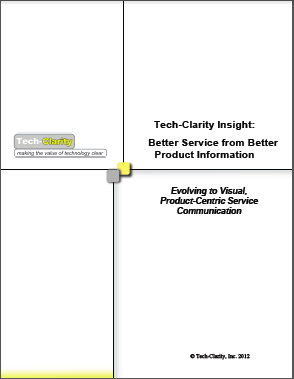 Tech-Clarity Insight: Better Service from Better Product Information: Evolving to Visual, Product-Centric Service Communication discusses the importance of having accurate, timely product information at hand in order to profit from service and satisfy customers in the service lifecycle. Highlights the importance of detailed, visual service information such as 3D graphics and animations to communicate product details, and explains how companies are leveraging PLM assets to improve service performance.
Please enjoy the free Executive Summary below, or click the report title above to download the full PDF (free of charge, no registration required).
Tech-Clarity Insight: Better Service from Better Product Information: Evolving to Visual, Product-Centric Service Communication discusses the importance of having accurate, timely product information at hand in order to profit from service and satisfy customers in the service lifecycle. Highlights the importance of detailed, visual service information such as 3D graphics and animations to communicate product details, and explains how companies are leveraging PLM assets to improve service performance.
Please enjoy the free Executive Summary below, or click the report title above to download the full PDF (free of charge, no registration required).
Table of Contents
- Executive Overview
- The Service Imperative – Opportunity and Challenge
- Bring Speed and Accuracy to Service Information
- Enhance Service Illustrations
- Leverage Existing Assets for Improved Communication
- Move Beyond Pictures to Products
- Service the Product across the Lifecycle – Managing Change
- Evolve to Structured, Product-Centric Service Communications
- Conclusion
- Recommendations
- About the Author
Executive Overview
Service is critical to company profitability and customer satisfaction for today’s manufacturer. This puts significant pressure on service organizations to perform. They have to close service calls quickly to save time and money. More importantly, they must service equipment accurately to keep customers happy and ensure they get maximum value from the products they buy. As Andrew Miller, Technical Consultant for Whirlpool explains, “Our ultimate goal is ‘first call complete,’ our customers rely on our products.” This is strategic, as Tech-Clarity’s report The Service Lifecycle Management Approach: Strong Customer Relationships Result in Profit in the Service Industry concludes, “Customer satisfaction is extremely important to building long term relationships. It is also good business, because it leads to greater profitability through customer retention and repeat business.” To service products effectively and efficiently, technicians need to be armed with the right product information. Timely, accurate, and easy access to service manuals, training materials, and customer service information is critical. “Documentation is an invisible aspect of service, one of our top two business priorities,” says Debra West-Maciaszek, Sr. Information Architect for Nikon’s Precision Equipment Business. “When things go wrong, you can often trace it back to a missing or inaccurate graphic.” Without the right information service technicians and customers have to reinvent processes and make guesses, neither of which are conducive to doing the job quickly or correctly. Modern service information should be highly graphical to enhance communication and cut across language barriers. Beyond simple 2D illustrations, 3D service communications provide an even richer way to communicate with ease and accuracy. Gene Harrel, Supervisor for Technical Manuals at General Atomics, says simply, “3D is much easier to use.” 3D is far more realistic, and interactive 3D allows technicians to rotate, explode, and interact more naturally with the product information. Beyond compelling graphics, service communications must provide product and service information in the context of the product. To address this, companies are beginning to address service as an extension of their Product Lifecycle Management (PLM) infrastructure. This allows them to take a holistic approach, share more accurate product data, manage communications throughout the changing product lifecycle, and bring about tighter linkages between Engineering and Service organizations and information. [post_title] => Better Service from Better Product Information [post_excerpt] => [post_status] => publish [comment_status] => open [ping_status] => open [post_password] => [post_name] => service-comm [to_ping] => [pinged] => [post_modified] => 2022-11-14 22:27:23 [post_modified_gmt] => 2022-11-15 03:27:23 [post_content_filtered] => [post_parent] => 0 [guid] => http://tech-clarity.com/?p=2353 [menu_order] => 0 [post_type] => post [post_mime_type] => [comment_count] => 0 [filter] => raw ) [17] => WP_Post Object ( [ID] => 2032 [post_author] => 2 [post_date] => 2012-04-11 17:35:08 [post_date_gmt] => 2012-04-11 21:35:08 [post_content] =>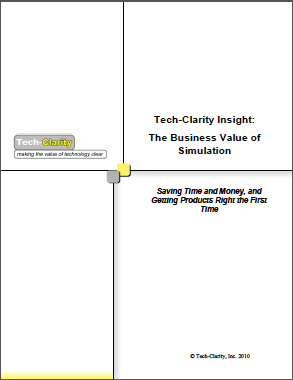 The Business Value of Simulation - Saving Time and Money, and Getting Products Right the First Time reviews how manufacturers can leverage simulation processes and technology to save time, reduce cost, drive efficiency, improve quality, and increase innovation. Discusses the economic value available from early design analysis and validation.
Please enjoy the free Executive Summary below, or click the report title above to download the full PDF (free of charge, no registration required).
Table of Contents
The Business Value of Simulation - Saving Time and Money, and Getting Products Right the First Time reviews how manufacturers can leverage simulation processes and technology to save time, reduce cost, drive efficiency, improve quality, and increase innovation. Discusses the economic value available from early design analysis and validation.
Please enjoy the free Executive Summary below, or click the report title above to download the full PDF (free of charge, no registration required).
Table of Contents
- Executive Overview
- Product Development Challenges
- The Economics of Simulation
- Getting the Product Right the First Time
- Raising the Bar on “Right”
- Baking Simulation into the Design Process
- Conclusion
- Recommendations
- About the Author
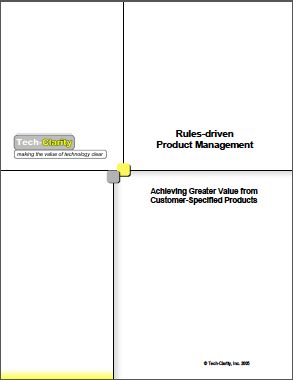 Rules-driven Product Management: Achieving Greater Value from Customer-Specified Products highlights the manufacturing strategy of customizing products to exact customer specifications to combat commoditization, globalization, margin shrink and increased competition, and how Rules-driven Product Management can help.
Please enjoy the free Executive Summary below, or click the report title above to download the full PDF (free of charge, no registration required).
Table of Contents
Rules-driven Product Management: Achieving Greater Value from Customer-Specified Products highlights the manufacturing strategy of customizing products to exact customer specifications to combat commoditization, globalization, margin shrink and increased competition, and how Rules-driven Product Management can help.
Please enjoy the free Executive Summary below, or click the report title above to download the full PDF (free of charge, no registration required).
Table of Contents
- Executive Overview
- Eliminating Product Management Guesswork
- A Different Product, Every Time
- Customization without Sacrificing Responsiveness
- Proposal Speed without Sacrificing Margins
- Delivery Speed without Sacrificing Design Quality
- Quality without Sacrificing Efficiency
- Leveraging Corporate Product Knowledge
- Rules-driven Product Management
- An RPM Example
- Summary
- About the Author
Register for the Pipeline Event 
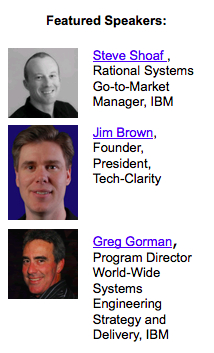 Take a look at this webcast on Dr. Dobb's to hear me discuss some tips on how manufacturers can use systems engineering best practices to improve product development. There is more embedded software in today's products than ever - it's time for manufacturers to learn how to take advantage of the opportunities it offers while maintaining quality and productivity.
It's worth a listen, if not for me for the great commentary by Steve Shoaf and Greg Gorman of IBM.
View the replay now
View the Related Tech-Clarity Spotlight Paper
[post_title] => Dr. Dobb's Webcast - Ten Point Guide to Streamlining Product Development with Systems Engineering
[post_excerpt] =>
[post_status] => publish
[comment_status] => open
[ping_status] => open
[post_password] =>
[post_name] => webcast-10-sys
[to_ping] =>
[pinged] =>
[post_modified] => 2022-11-14 22:26:33
[post_modified_gmt] => 2022-11-15 03:26:33
[post_content_filtered] =>
[post_parent] => 0
[guid] => http://tech-clarity.com/?p=2365
[menu_order] => 0
[post_type] => post
[post_mime_type] =>
[comment_count] => 4
[filter] => raw
)
[comment_count] => 0
[current_comment] => -1
[found_posts] => 802
[max_num_pages] => 41
[max_num_comment_pages] => 0
[is_single] =>
[is_preview] =>
[is_page] =>
[is_archive] =>
[is_date] =>
[is_year] =>
[is_month] =>
[is_day] =>
[is_time] =>
[is_author] =>
[is_category] =>
[is_tag] =>
[is_tax] =>
[is_search] =>
[is_feed] =>
[is_comment_feed] =>
[is_trackback] =>
[is_home] => 1
[is_privacy_policy] =>
[is_404] =>
[is_embed] =>
[is_paged] =>
[is_admin] =>
[is_attachment] =>
[is_singular] =>
[is_robots] =>
[is_favicon] =>
[is_posts_page] =>
[is_post_type_archive] =>
[query_vars_hash:WP_Query:private] => 07f937f16810acda2f644abd0e6fe851
[query_vars_changed:WP_Query:private] => 1
[thumbnails_cached] =>
[allow_query_attachment_by_filename:protected] =>
[stopwords:WP_Query:private] =>
[compat_fields:WP_Query:private] => Array
(
[0] => query_vars_hash
[1] => query_vars_changed
)
[compat_methods:WP_Query:private] => Array
(
[0] => init_query_flags
[1] => parse_tax_query
)
[query_cache_key:WP_Query:private] => wp_query:d089eb1f3cbdbe1cf73b8e41dd300686:0.76585500 17646661560.77565900 1764666156
)
Take a look at this webcast on Dr. Dobb's to hear me discuss some tips on how manufacturers can use systems engineering best practices to improve product development. There is more embedded software in today's products than ever - it's time for manufacturers to learn how to take advantage of the opportunities it offers while maintaining quality and productivity.
It's worth a listen, if not for me for the great commentary by Steve Shoaf and Greg Gorman of IBM.
View the replay now
View the Related Tech-Clarity Spotlight Paper
[post_title] => Dr. Dobb's Webcast - Ten Point Guide to Streamlining Product Development with Systems Engineering
[post_excerpt] =>
[post_status] => publish
[comment_status] => open
[ping_status] => open
[post_password] =>
[post_name] => webcast-10-sys
[to_ping] =>
[pinged] =>
[post_modified] => 2022-11-14 22:26:33
[post_modified_gmt] => 2022-11-15 03:26:33
[post_content_filtered] =>
[post_parent] => 0
[guid] => http://tech-clarity.com/?p=2365
[menu_order] => 0
[post_type] => post
[post_mime_type] =>
[comment_count] => 4
[filter] => raw
)
[comment_count] => 0
[current_comment] => -1
[found_posts] => 802
[max_num_pages] => 41
[max_num_comment_pages] => 0
[is_single] =>
[is_preview] =>
[is_page] =>
[is_archive] =>
[is_date] =>
[is_year] =>
[is_month] =>
[is_day] =>
[is_time] =>
[is_author] =>
[is_category] =>
[is_tag] =>
[is_tax] =>
[is_search] =>
[is_feed] =>
[is_comment_feed] =>
[is_trackback] =>
[is_home] => 1
[is_privacy_policy] =>
[is_404] =>
[is_embed] =>
[is_paged] =>
[is_admin] =>
[is_attachment] =>
[is_singular] =>
[is_robots] =>
[is_favicon] =>
[is_posts_page] =>
[is_post_type_archive] =>
[query_vars_hash:WP_Query:private] => 07f937f16810acda2f644abd0e6fe851
[query_vars_changed:WP_Query:private] => 1
[thumbnails_cached] =>
[allow_query_attachment_by_filename:protected] =>
[stopwords:WP_Query:private] =>
[compat_fields:WP_Query:private] => Array
(
[0] => query_vars_hash
[1] => query_vars_changed
)
[compat_methods:WP_Query:private] => Array
(
[0] => init_query_flags
[1] => parse_tax_query
)
[query_cache_key:WP_Query:private] => wp_query:d089eb1f3cbdbe1cf73b8e41dd300686:0.76585500 17646661560.77565900 1764666156
)
All Results for "All"
Consolidating Design Software
Issue in Focus: Consolidating Design Software: Extending Value Beyond 3D CAD Consolidation discusses the value of consolidating on suites of engineering and design tools to take advantage of integration to increase efficiency, remove the need to translate CAD files, and maintain design intent throughout the design process. Please enjoy the free Executive Summary below, or…
Webcast on Meeting Inflexible Product Development Launch Windows
Please join us as Jim Brown presents his research on Product Portfolio Management (PPM) in this CGT webcast, How to Effectively Manage Your Product Portfolio to Consistently Hit Launch Windows. Please join the live event on August 16 or view the on-demand, recorded webcast at your convenience. Jim is joining Monica Alderson, Project Management Director…
Assessing the Cloud PLM Opportunity
Issue in Focus: Assessing the Cloud PLM Opportunity: Evaluating the Benefits, Requirements, and Considerations explores the opportunity to leverage cloud computing technology with PLM (Product Lifecycle Management). The paper is intended to help companies evauluating PLM in the cloud by sharing information and experiences from more mature cloud enterprise applications including CRM. Please enjoy the…
The Business of 3D Technical Communications: Evolving Strategies to Document Products
Tech-Clarity Insight: The Business of 3D Technical Communications: Evolving Strategies to Document Products explains how companies are changing their views on technical documentation to a more strategic approach, including the use of 3D to go beyond flat, static documents to incorporate richer, interactive, more realistic representation of products. Please enjoy the free Executive Summary below,…
Social Business Collaboration and the Product Lifecycle
Issue in Focus: Social Business Collaboration and the Product Lifecycle: Combining the Collaborative Power of Social Media with PLM explores the possibility that companies could adopt a social business collaboration platform to improve product development processes and add proven PLM capabilities as needed to establish a socially capable PLM system. Tech-Clarity believes that social product…
Consolidating CAD – Benefits of a Unified CAD Strategy
Tech-Clarity Insight: Consolidating CAD – Benefits of a Unified CAD Strategy examines the strategic and tactical value of standardizing on a single CAD package. The research papers provides a framework for determining the cost savings available from consolidating tools. Please enjoy the free Executive Summary below, or click the report title above to download the…
Best Practices for Managing Design Data Survey Report
Tech-Clarity Perspective: Best Practices for Managing Design Data – How Effective Data Management Fundamentals Enable World-Class Product Development shares survey results on the processes and technology that top-performing manufacturers use to manage their technical product data. The survey benchmarks manufacturers on their design performance and determines which respondents outperform the others in: Designing high quality…
Integrating PLM and MES – Realizing the Digital Factory
Tech-Clarity Insight Integrating PLM and MES – Realizing the Digital Factory expands the discussion on the roles that ERP and PLM play in manufacturing to include the role of Manufacturing Execution Systems (MES). The paper discusses the business need for integrating the solutions, automating the integrated product and production lifecycle, and closing the loop between…
Digital Prototyping in the Plant
Tech-Clarity Issue in Focus: Digital Prototyping in the Plant: Improving Manufacturing Agility with the Digital Factory discusses how digital prototyping solutions can help manufacturers achieve greater agility by leveraging a digital factory approach. This is particularly important today as the manufacturing industries – particularly the automotive industry – are faced with the need to drastically…
Systems Engineering and PLM Webcast
Jim Brown will share his views in a webcast titled Best Practices for Systems Engineering using Product Lifecycle Management. This joint webcast with Tech-Clarity and Siemens PLM Software will discuss how leading companies are leveraging system engineering and Product Lifecycle Management (PLM) concepts and approaches to define, model and analyze the product while ensuring that…
The Integrated ERP-PLM Strategy
Insight: The Integrated ERP-PLM Strategy: Closing the Loop on Product Innovation reviews the importance of an integrated ERP-PLM strategy to provide a rapid, confident flow of innovation information to and from Manufacturing. The paper discusses a strategy to close the loop between Engineering and Manufacturing to get the most business value from innovation in all…
Product Data Accessibility
Issue in Focus: Product Data Accessibility: Getting Value from All of Your Product Data explains the importance for manufacturers to be able to access and share product data, regardless of whether it is centralized in a system like PDM or not. Explains that accessing product data and centralizing it are not absolutely linked, and describes…
Managing Engineering Data
Tech-Clarity Insight: Managing Engineering Data – The Role of Product Data Management in Improving Engineering Efficiency shares the benefits of controlling engineering data and collaborating with PDM. The research discusses extending PDM with product-related processes and expanding implementations beyond engineering data. Please enjoy the free Executive Summary below, or click the report title above to…
The Business Value of Product Data Management
Tech-Clarity Insight: The Business Value of Product Data Management: Achieving Rapid and Extendable Benefits explains how manufacturers use PDM to control their product data, improve their ability to find information, and better share knowledge with other departments. The report shares the experiences of three manufacturers that took a more “out of the box” approach to…
CGT Webcast on Improving Innovation and Value Creation despite Regulation in CPG
Jim Brown will present in this Consumer Goods Technology webcast sponsored by Dassault Systemes. Jim will share his perspectives on how companies can develop highly innovative products in shorter time through the use of best practices and PLM technology. CPG companies face extreme demands on innovation and market responsiveness, but they must also navigate a…
Better Service from Better Product Information
Tech-Clarity Insight: Better Service from Better Product Information: Evolving to Visual, Product-Centric Service Communication discusses the importance of having accurate, timely product information at hand in order to profit from service and satisfy customers in the service lifecycle. Highlights the importance of detailed, visual service information such as 3D graphics and animations to communicate product…
The Business Value of Simulation
The Business Value of Simulation – Saving Time and Money, and Getting Products Right the First Time reviews how manufacturers can leverage simulation processes and technology to save time, reduce cost, drive efficiency, improve quality, and increase innovation. Discusses the economic value available from early design analysis and validation. Please enjoy the free Executive Summary…
Rules-driven Product Management
Rules-driven Product Management: Achieving Greater Value from Customer-Specified Products highlights the manufacturing strategy of customizing products to exact customer specifications to combat commoditization, globalization, margin shrink and increased competition, and how Rules-driven Product Management can help. Please enjoy the free Executive Summary below, or click the report title above to download the full PDF (free…
Getting the PPM Band Back Together at Pipeline 2012
We are getting the whole gang back together for a great online conference – Pipeline 2012 – The Online Conference for Innovative Product Development. Last year I had the privilege of presenting at the Pipeline 2011 event. My presentation, Social Computing and the Product Lifecycle, focused on the applicability of social computing to improve different…
 Issue in Focus: Consolidating Design Software: Extending Value Beyond 3D CAD Consolidation
Issue in Focus: Consolidating Design Software: Extending Value Beyond 3D CAD Consolidation